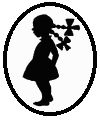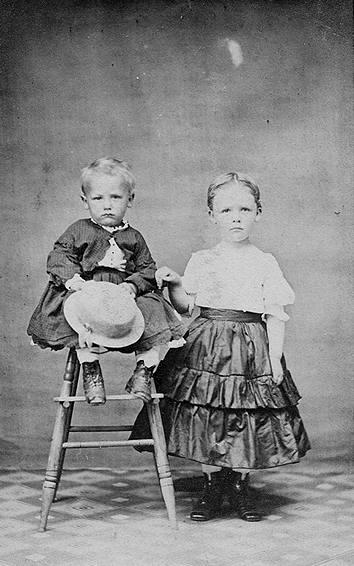

United States Girls' Garments: Skirts

Figure 1.--This Civil War era CDV portrait shows an unidentified little boy and his big sister. While unidentified, the older child's center part strongly suggests a girl. The boy is seated in a chair. The chair was a device used to raise the boy's head to the same height as his sister. He wears a dark jacket and what looks to be a matching skirt and a blouse with a ruffled collar. He holds a large straw hat. His sister stands next to him wearing a white blouse with short sleeves and a satin skirt. Notice how different the skirts were. Fancu skirts like this were much more likely to be worn by girlsa. We know the portrait was taken in 1864-66 because there was an orange 2 cent revenue (bank check) stamp on the back.
|
|
We have little information about the skirts worn by girls. We know that skirts were worn, bur we are unsure how commonly or how the skirts worn by girls and boys may have differed. This is somewhat complicated by the fact that our assessment is primarily based on photography and of course photography on;y became available in thec1840s, So we have virtually no information before this. Paintings and fashion illustrations primarily depict children in dresses. Thus we are not sure about the blouses and skirts children wore. We know that girls wore skirts, although most portraits depict them in dresses. This suggests that the skirt was more of an informal garment. Here we want to develop information on not only the skirts, but the blouses hirls wote with them. And how they differed with the blouses and skirts worn by boys. A complication here is another event occurring in the 1840s. Queen Victoria began dressing the princes in kilts. This essentially created a male skirt garment. Not all the skirts worn by boys after the 1840s were kilts, but quite a large number either were kilt-like garments or had at least a degree of kilt styling. An element here was pleats which eventually became popular for girls skirts as well. A good example is Frances Wells Quintin who wears a sailor-styled blouse with a skirt.
HGC

Navigate Related HBC pages
[Ringlet curls]
[Blouses]
[Ties]
[Skirts]
[Long stockings]
[Footwear]
Navigate the Boys' Historical Clothing Web Site:
[Return to the Main U.S. skirt page]
[Return to the Main U.S. kilt page]
[Return to the Main U.S. skirted garment page]
[Return to the Main U.S. country garment page]
[Return to the Main girls' skirt page]
[Introduction]
[Activities]
[Biographies]
[Chronology]
[Clothing styles]
[Countries]
[Bibliographies]
[Contributions]
[FAQs]
[Glossary]
[Images]
[Links]
[Registration]
[Tools]
[Boys' Clothing Home]
Created: 3:10 AM 10/5/2009
Last updated: 5:09 AM 3/24/2010




